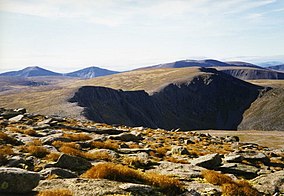
Back كيرنجورمز ARZ Am Monadh Ruadh Breton Cairngorms Catalan Cairngorms Mountains CEB Cairngorms Czech Cairngorms Welsh Cairngorms German Cairngorms Spanish Cairngorms Basque Cairngorms French
| Cairngorms | |
|---|---|
IUCN category IV (habitat/species management area) | |
 Cairn Gorm view over Coire an t-Sneachda, a glacial cirque | |
| Location | Highland, Aberdeenshire and Moray, Scotland |
| Nearest city | Inverness, Aberdeen |
| Coordinates | 57°06′N 3°41′W / 57.10°N 03.68°W |
| Area | 292 km2 (113 sq mi)[1] |
| Established | 1987[1] |
| Governing body | NatureScot |
The Cairngorms (Scottish Gaelic: Am Monadh Ruadh) are a mountain range in the eastern Highlands of Scotland closely associated with the mountain Cairn Gorm. The Cairngorms became part of Scotland's second national park (the Cairngorms National Park) on 1 September 2003.[2] Although the Cairngorms give their name to, and are at the heart of, the Cairngorms National Park, they only form one part of the national park, alongside other hill ranges such as the Angus Glens and the Monadhliath, and lower areas like Strathspey.[3]
The Cairngorms consists of high plateaux at about 1,000–1,200 m (3,300–3,900 ft) above sea level, above which domed summits (the eroded stumps of once much higher mountains [4]) rise to around 1,300 m (4,300 ft). Many of the summits have tors, free-standing rock outcrops that stand on top of the boulder-strewn landscape.[5] In places, the edges of the plateau form steep cliffs of granite and they are excellent for skiing, rock climbing and ice climbing. The Cairngorms form an arctic-alpine mountain environment, with tundra-like characteristics and long-lasting snow patches.[5] This area is home to bird species such as ptarmigan, dotterel, snow bunting, curlew and red grouse, as well as mammals such as mountain hare.[6] The plateau also supports Britain's only herd of reindeer (albeit semi-domesticated).[7] Surrounding the central massif are many remnants of the Caledonian forest in straths and glens of the Rivers Spey and Dee.[8] These forests support many species that are rare elsewhere in Britain, including red squirrels, pine marten, wood ants, Scottish crossbill, capercaillie and crested tit.[9]
There are no glaciers, but snow can fall in any month of the year, and snow patches usually persist all summer; for snow and ice climbing, the area is the most dependable in Britain.[10][11] The mountains are also popular for hill-walking, ski touring and climbing, and there are three alpine ski centres in the range, at Cairn Gorm, The Lecht and Glenshee.
The range lies in the Scottish council areas of Aberdeenshire, Moray and Highland,[12] and within the counties of Aberdeenshire, Inverness-shire and Banffshire.
- ^ a b "Cairngorms SSSI". NatureScot. Retrieved 2 October 2020.
- ^ "History Leading to the Cairngorms National Park". Cairngorms National Park Authority. Archived from the original on 15 January 2018. Retrieved 15 January 2018.
- ^ "Cairngorms Landscapes". Cairngorms National Park. Retrieved 20 February 2018.
- ^ Allen & Davidson (2012), Prologue: The Mountains, p. 1/14.
- ^ a b "Landscape Character Assessment - The Cairngorms Massif" (PDF). Cairngorms National Park Authority. Archived from the original (PDF) on 20 February 2018. Retrieved 20 February 2018.
- ^ "What to look for in mountains and moorlands". Cairgorms Nature (Cairngorms National Park Authority). Retrieved 20 February 2018.
- ^ Cite error: The named reference
reindeerwas invoked but never defined (see the help page). - ^ "Cairngorms National Park". walkhighlands.co.uk. Retrieved 20 February 2018.
- ^ "What is left of the Old Caledonian Forest - and can it be saved?". The Scotsman. 11 February 2016. Retrieved 20 February 2018.
- ^ Watson (1992), p. 16.
- ^ English, Charlie (7 February 2009). "Doctor Watson's feeling for snow". Guardian. Archived from the original on 25 March 2016. Retrieved 20 February 2016.
- ^ Cite error: The named reference
sheet36was invoked but never defined (see the help page).
© MMXXIII Rich X Search. We shall prevail. All rights reserved. Rich X Search
